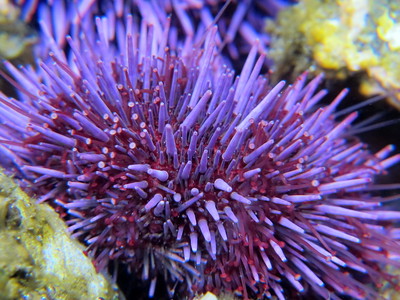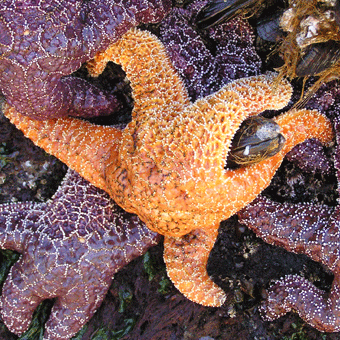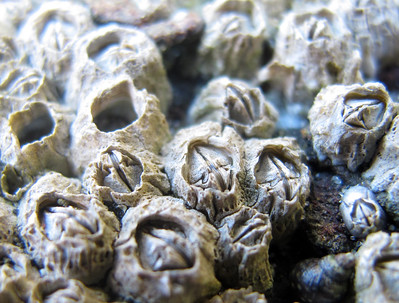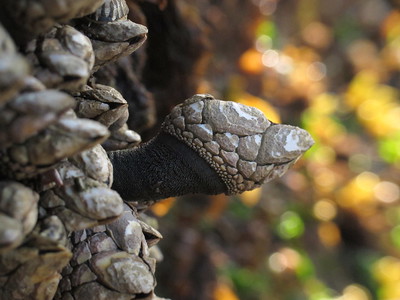Inhabitants of Oregon's Tidepools: Purple Sea Urchin
Though not especially sharp, purple sea urchin spines are strong enough to wear away bits of rock.
 Over time, generations of urchins form the shallow pits they live in. The urchin hangs on to the rock and to the bits of shell and rocks that you might see on the urchin, with tiny tube feet that make up part of the soft tissue between the spines. The pits are great refuge from roiling water during high tide and can make mini-tidepools at low tide. This protection makes the pits valuable real estate and many animals can be found living under and alongside the urchins.
Over time, generations of urchins form the shallow pits they live in. The urchin hangs on to the rock and to the bits of shell and rocks that you might see on the urchin, with tiny tube feet that make up part of the soft tissue between the spines. The pits are great refuge from roiling water during high tide and can make mini-tidepools at low tide. This protection makes the pits valuable real estate and many animals can be found living under and alongside the urchins.
Purple sea urchins munch kelp with the five-toothed mouth on the underside, moving to dinner or pulling the meal in using the tube feet. As with its relative the seastars, pulling urchins off the rock or out of their pits can rip off tube feet they need to stay put.
The shell beneath the spines is fragile, brittle—and beautiful. Small knobs, arranged in top-to-bottom rows, are where the spines articulated when the animal was alive. Delicate lines of tiny holes trace elaborate patterns around the knobs; soft tissue with the tube feet and gills reach outside through the holes. The shell, called a test, breaks into sections along zigzag lines.
Sea urchins are five-parted like other echinoderms (including seastars and sea cucumbers): look for patterns of five in the arrangement of sea urchin anatomy.
Inhabitants of Oregon's Tidepools: Ochre Sea Star

Sea stars don’t show signs of growing old.
While human bodies age and change in our later decades, sea stars—and most other invertebrates—don’t go through such transformations.
Our common ochre sea stars ("starfish") can survive many years in tidepools by being patient and tough: they cling tightly to the rock and move slowly by using the rows of tube feet on the underside; small plates just under the surface makes their bodies rather hard and a little stiff. The soft tissues between the hard bumps on the back include tiny pinchers that fend off parasites and some potential predators.
Sea stars cannot survive, however, if they’re exposed to air and sun too long, or if they get too warm, or if they’re unable to attach: pulling them off the rocks and/or moving them can end their long lives. “If you pry, it will die.”
How does an ochre sea star eat?
Ochre sea stars have a mouth in the center of the bottom, but a mouth that’s too small to accommodate most of the seastar’s prey. Instead of putting food in its stomach, this sea star pushes its stomach out of the mouth and into, or onto, the prey to digest it. The stomach is pulled back into the sea star’s body when done eating.
Mussels, this sea star’s favorite food, must first be pried open to allow the sea star entry. The mussel is initially stronger than the sea star, but the sea star is more patient: eventually the mussel tires of fighting the sea star and allows the shell to gap enough for the sea star to get inside.
Inhabitants of Oregon's Tidepools: Acorn barnacles
Sweep, sweep, sweep…
When the sea returns to a barnacle’s home, the barnacle will open the two doors in the center and extend its ten feathery legs beyond the protective walls. Opening and closing at a measured pace, the barnacle’s curved legs sweep the water for its food: plankton and detritus. Find some barnacles still submerged in a quiet tidepool and you’ll be able to watch the graceful dance.
 With the doors tightly shut and the walls intact, the barnacles are protected from drying out and from many potential predators, and are protected from heavy surf. Almost as hard as the rocks they’re attached to, barnacles hard enough to scratch and cut people, but soft enough to be easily crushed by scuffing feet and walking sticks: Please take care to not get cut by the barnacles or to crush them.
With the doors tightly shut and the walls intact, the barnacles are protected from drying out and from many potential predators, and are protected from heavy surf. Almost as hard as the rocks they’re attached to, barnacles hard enough to scratch and cut people, but soft enough to be easily crushed by scuffing feet and walking sticks: Please take care to not get cut by the barnacles or to crush them.
These barnacles may attach to anything hard, including driftwood, mussels, black turban snails and other molluscs—even the backs of crabs.
Oregon’s tidepools are home to several species of barnacles, each with a slightly different texture and door shape. If a patch of barnacles grow long enough and big enough, they’ll crowd each other and be forced to grow upwards only, with each barnacle becoming tall and narrow.
Inhabitants of Oregon's Tidepools: Gooseneck Barnacles

The flexible stalks may be hidden, covered by the hard shells.
Dozens of off-white plates form two shielding halves around the bulk of the gooeseneck (leaf) barnacle’s body; a tough, rubbery stalk connects it to the rock. A great combination in the gooseneck barnacle’s heavy surf habitat: armor and give.
Water currents or cascades will entice the gooseneck barnacle to gape those shielding halves and extend its ten feathery legs to feed on plankton and detritus in the water. The long slits between the halves are parallel to the main water current.
While well-adapted to wave action, leaf barnacles cannot stand up to scuffing human feet.

